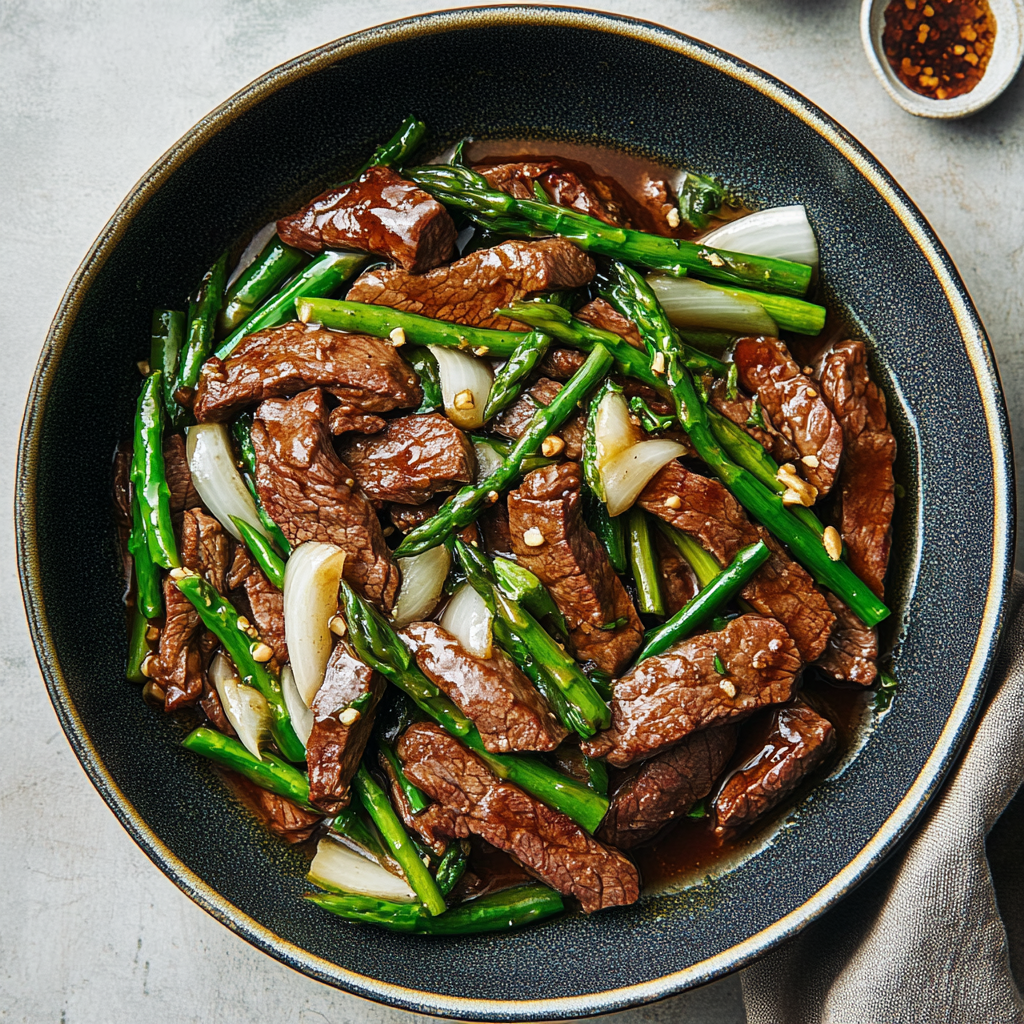Beef with oyster sauce is a classic Chinese dish that combines tender beef with crisp asparagus in a savory and slightly sweet brown sauce. The secret to achieving the perfect texture lies in marinating the beef with baking soda, which helps tenderize the meat and lock in moisture. This dish is not only quick and easy to prepare but also versatile, allowing you to substitute asparagus with other vegetables like bell peppers or baby bok choy.
Whether you’re new to Chinese cooking or a seasoned home chef, this recipe offers a delightful balance of flavors and textures. The rich umami of the oyster sauce pairs beautifully with the freshness of the vegetables, creating a satisfying meal that’s perfect for any night of the week. Serve it over steamed white rice for a complete and comforting dish.
Full Recipe
Ingredients:
For the Marinade:
-
1 lb beef flank steak (or skirt steak)
-
1/2 teaspoon baking soda
-
1 tablespoon light soy sauce (or tamari for gluten-free)
-
1 teaspoon peanut oil
-
2 teaspoons cornstarch
For the Sauce:
-
1/2 cup chicken broth
-
2 tablespoons oyster sauce (or gluten-free oyster sauce)
-
1 tablespoon light soy sauce (or tamari)
-
1 teaspoon dark soy sauce (or tamari)
-
2 teaspoons sugar
-
2 teaspoons cornstarch
-
1 teaspoon sesame oil
For Stir-Frying:
-
2 tablespoons peanut oil (or vegetable oil)
-
1/2 white onion, sliced
-
3 cloves garlic, sliced
-
1 thumb-sized piece of ginger, sliced
-
1 lb asparagus, tough ends removed and cut into bite-sized pieces (or 1 bell pepper)
Directions:
-
In a medium-sized bowl, combine the beef with baking soda, light soy sauce, peanut oil, and cornstarch. Mix well and let marinate while you prepare the other ingredients.
-
In a small bowl, mix together the chicken broth, oyster sauce, light soy sauce, dark soy sauce, sugar, cornstarch, and sesame oil to make the sauce. Set aside.
-
Heat 1 tablespoon of oil in a large skillet over medium-high heat until hot. Add the marinated beef and spread it out into a single layer without overlapping. Cook until the bottom turns golden, about 1 minute. Flip to cook the other side until just cooked, about 1 minute more. Transfer the beef to a large plate.
-
Add the remaining 1 tablespoon of oil to the skillet. Add the sliced onion, garlic, and ginger. Cook and stir for 2 minutes until fragrant.
-
Add the asparagus to the skillet. Cook until just starting to soften, about 1 minute.
-
Stir the sauce again to fully dissolve the cornstarch and pour it into the pan. Stir a few times until it thickens.
-
Return the cooked beef to the pan and stir to coat everything well. Transfer everything to a big plate and serve hot as a main dish.
Prep Time: 20 minutes
Cooking Time: 10 minutes
Total Time: 30 minutes
Kcal: 269 kcal per serving
Servings: 4 servings
Introduction to Beef with Oyster Sauce
Beef with Oyster Sauce is a beloved dish in Chinese cuisine, celebrated for its bold umami flavor, quick cooking process, and versatility. This dish combines tender slices of marinated beef with crisp vegetables—commonly asparagus, bok choy, or bell peppers—stir-fried in a savory brown sauce enriched with oyster sauce, soy sauce, and aromatics. Its simplicity, speed, and crowd-pleasing taste make it a staple both in Chinese households and takeout menus worldwide.
Originating from Cantonese culinary traditions, this recipe captures the balance and depth that define Chinese stir-fries. It’s a perfect introduction for home cooks exploring Chinese flavors, yet it remains a favorite for seasoned food lovers due to its comfort-food appeal and ability to adapt to different dietary needs or seasonal vegetables.
Cultural Significance and Origin
Beef with Oyster Sauce traces its roots to southern China, particularly Guangdong (Canton) province. Oyster sauce itself was developed in the late 19th century by accident when a chef overcooked oyster soup into a thick, brown sauce with a deep, rich flavor. Since then, oyster sauce has become a pantry staple in Chinese cooking, particularly in dishes requiring that quintessential “wok hei” flavor — a smoky, charred aroma achieved from cooking over high heat.
In Chinese culinary culture, beef symbolizes prosperity and strength, and this dish is often served during festive occasions, family gatherings, or weekend dinners. Its balance of meat and vegetables aligns with the Chinese philosophy of harmony in flavors and nutrition.
Why This Dish Works
What makes Beef with Oyster Sauce so satisfying is the perfect blend of taste and texture. The marinade helps tenderize the beef, giving it a silky, melt-in-your-mouth quality. Stir-frying over high heat locks in flavor and texture, producing vibrant vegetables and juicy slices of beef in just minutes.
Oyster sauce, the star of the dish, delivers a concentrated dose of umami. Combined with soy sauces (light and dark), sugar, sesame oil, and stock, it creates a rich, glossy sauce that clings beautifully to every bite. Add to that the aromatic foundation of garlic, ginger, and onions, and you get a dish that is both bold and balanced.
Health Benefits and Nutritional Profile
Beef with Oyster Sauce is not only tasty but can also be quite nutritious. Lean cuts of beef provide high-quality protein, iron, and B vitamins. When paired with vegetables like asparagus, broccoli, or bell peppers, the dish becomes a well-rounded meal full of fiber, antioxidants, and essential vitamins.
Despite being stir-fried, the cooking method uses minimal oil and retains most of the nutrients in the ingredients. You can make the dish even healthier by using low-sodium soy sauce or a gluten-free version if needed. For those monitoring carbs, pairing the dish with brown rice or serving it over steamed vegetables keeps it within a healthy range.
Versatility in Ingredients
One of the best things about this dish is how flexible it is. While flank steak is a classic choice for its tenderness and quick-cooking properties, you can substitute it with sirloin, skirt steak, or even chicken or tofu for a different take. The vegetables can be swapped depending on the season or what you have on hand—think snap peas, carrots, zucchini, or green beans.
The sauce is the heart of the recipe, and even here, you can customize it. Want a spicier version? Add chili flakes or fresh sliced red chilies. Prefer a more garlicky profile? Increase the garlic or add a dash of garlic chili sauce. The beauty lies in how easily this dish accommodates different tastes and dietary preferences.
Tips for Perfect Execution
-
Slice beef thinly and against the grain to ensure tenderness. This shortens the muscle fibers and prevents chewy textures.
-
Marinate the beef for at least 15–20 minutes. The combination of baking soda and cornstarch in the marinade helps tenderize and coat the meat, enhancing both texture and flavor absorption.
-
Use a hot wok or skillet to sear the meat quickly, locking in juices and achieving that signature “wok hei” flavor.
-
Don’t overcrowd the pan. If needed, cook the beef in batches to ensure a proper sear rather than steaming.
-
Always add the sauce last and stir until thickened. This coats the ingredients evenly and prevents the sauce from over-reducing or burning.
Pairing Suggestions
This dish is best enjoyed with a side of steamed white rice, which helps soak up the savory sauce. However, jasmine or brown rice, fried rice, or even noodles are excellent options. For a low-carb variation, try cauliflower rice or a bed of stir-fried greens.
Beverage pairings can range from jasmine tea to a light beer or even a crisp white wine like Sauvignon Blanc, which complements the umami notes and cuts through the richness of the sauce.
Serving Ideas and Presentation
Serve the dish immediately after cooking to enjoy it at its peak texture and flavor. Present it on a wide, shallow dish with the beef layered over vegetables and the glossy sauce drizzled generously over the top. Garnish with sliced scallions or sesame seeds for added aroma and visual appeal. A wedge of lime on the side can also brighten the flavor and add a zesty twist.
For entertaining, pair this dish with a few other small plates like dumplings, egg drop soup, or a cucumber salad for a full, Asian-inspired meal.
Common Mistakes to Avoid
-
Skipping the marinade can result in tougher beef with less flavor.
-
Using low heat will cause the beef to steam instead of sear, preventing caramelization.
-
Adding too much sauce too early can cause the ingredients to become soggy and overcooked.
-
Using too many vegetables at once may dilute the flavors and overfill the pan, preventing proper stir-frying.
Suitable for Meal Prep
Beef with Oyster Sauce is also a great candidate for meal prep. You can marinate the beef a day in advance, store pre-mixed sauce in a jar, and have the veggies cleaned and cut. It takes less than 10 minutes to bring everything together when it’s time to cook. Stored properly in an airtight container, the dish holds well in the refrigerator for 2–3 days and reheats nicely in a skillet or microwave.
Conclusion
Beef with Oyster Sauce is more than just a stir-fry—it’s a celebration of umami, texture, and culinary tradition. Its roots in Cantonese cooking give it authenticity, while its adaptability ensures it fits into modern kitchens everywhere. Whether you’re looking for a quick weeknight dinner, a dish to impress guests, or something new to break your meal routine, this savory stir-fry delivers in every bite.
Its tender beef, crisp vegetables, and glossy sauce make it irresistible. Add to that the ease of cooking and endless customization options, and you’ll find yourself turning to this dish time and time again. From beginner cooks to experienced chefs, everyone can appreciate the magic that a simple stir-fry like this can bring to the table.






